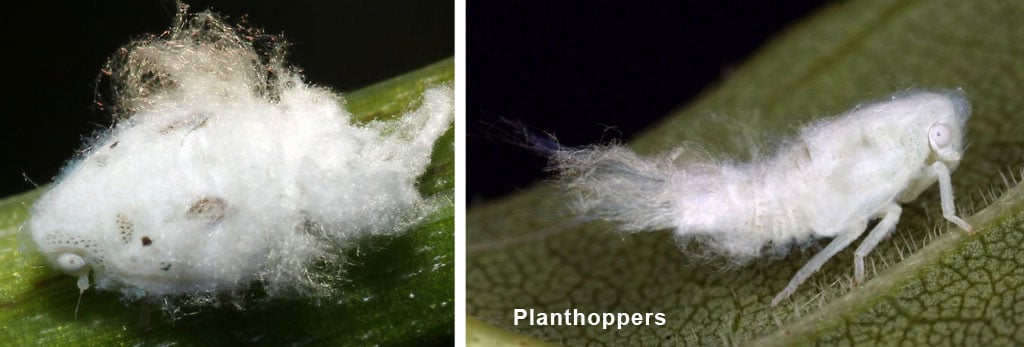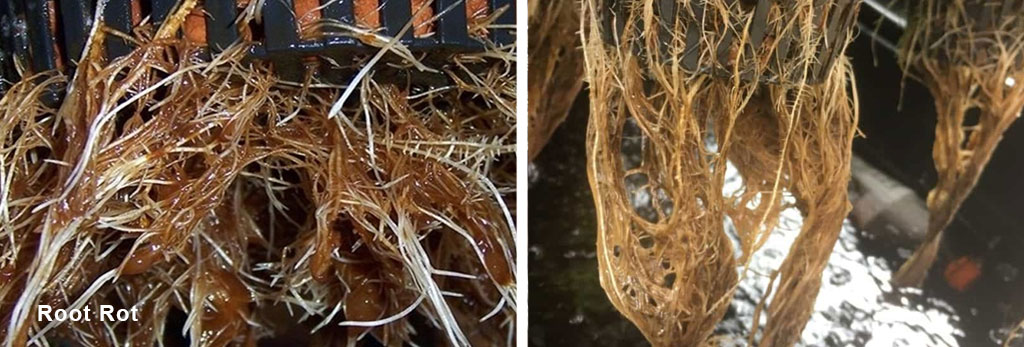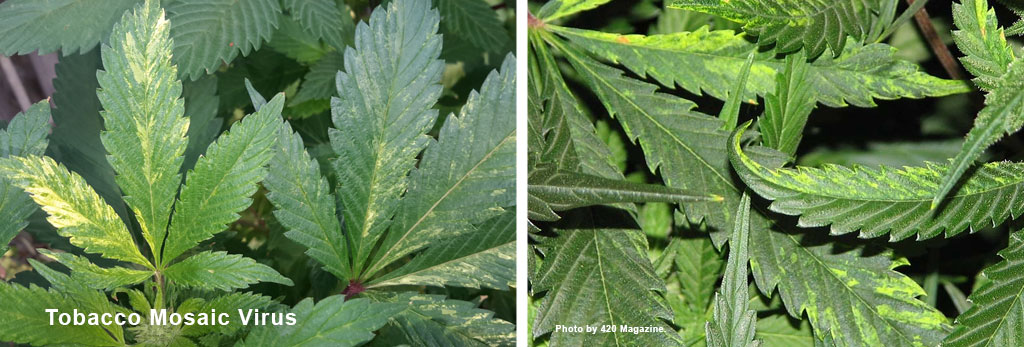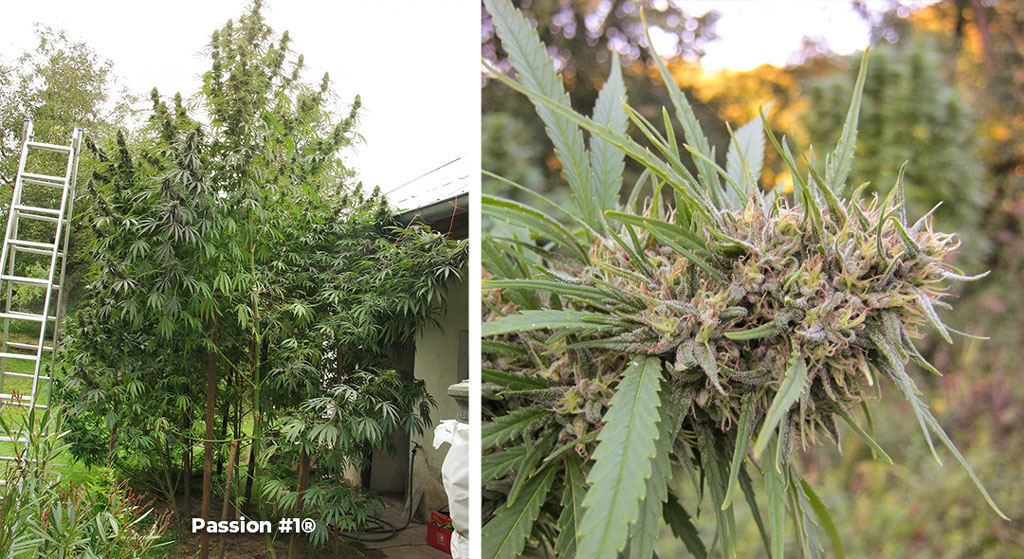A visual guide to cannabis pests and diseases

You may have invested in the best cannabis seeds, a high-end LED grow light and a sophisticated grow room. But all that can be decimated if pests and diseases get a grip on your crop. Many people don't know one pest from another, or the best way to eliminate them. But a quick read of this guide will explain all you need to know.
Identifying the most common cannabis pests
When caught in time, cannabis pests can be dealt with. The more serious problems tend to arise when pests are allowed time to establish themselves in your grow room. Some of the more difficult pests, and what to do about them, are discussed below.
It’s worth mentioning that many indoor growers (and greenhouse growers) now routinely add UVB supplemental lights to their grow location. The UVB emitted often has a positive effect at reducing (perhaps even eliminating) pests before they get chance to become established and is a good tool to control pests.
if you ever find and remove pest-damaged tissue/leaves from your plant, one useful tip is to ensure that you never keep this waste material in your grow room. Cannabis cuttings/clones from friends are another frequent source of unintended pests/disease. Leaving your indoor plants outside for an afternoon in the outdoor sun is also an excellent way to inadvertently introduce pests into your grow room.
Cannabis aphids

Cannabis aphids can be a serious nuisance to both indoor and outdoor growers. They are often found on the underside of leaves and come in an array of sizes according to their age and maturity.
Soap-based sprays can be useful to reduce aphid activity, so too can aphid predators such as Ladybirds, which can be bought online. Leaving an aphid infestation unchecked will allow rapid population expansion and a sticky mess on your plants which reduces harvest quality/quantity.
Barnacles / scale insects

These white or red creatures look similar to seaside barnacles and attach themselves to your plant stem, branches and leaves. They are also called wax scales. Like aphids they produce a sticky waste material known as honeydew all over your plants. Again, a soap spray can help remove them. So too can a powerful water spray, neem oil or predator insects such as lacewing and ladybirds.
Cannabis broad mites

Broad mites are a serious nuisance once established. They are so tiny you may not notice them, even with a magnifying glass. The tortured leaves look twisted, droopy, glossy, blistered, and unhealthy. Growers often mistake the infestation for pH, heat stress or nutrient problems, compounding the difficulties.
Specialist chemical sprays (known as Miticide sprays e.g. ‘Forbid’, ‘Avid’ & ‘IC3’) can be used but are often not favoured by cannabis growers. Instead, neem oil, soapy sprays. Mite predators such as Neoseiulus are a good help. Diatomaceous earth can also help.
Caterpillars & inchworms

These can munch through your plant leaves, often leaving black droppings. Removing them keeps your foliage intact and helps plant growth. Anti-Caterpillar sprays do exist, but with organic buds and a healthy smoke at the top of your priority list, it would be easier to pick the pests off by hand.
Crickets

Crickets will often feast on cannabis leaves but are easy enough to manually remove. Generally speaking, Crickets are not major pests however ‘Mole Crickets’ can bury into the cannabis root system and are a nuisance even though they are infrequently encountered. Plant netting can be useful to keep such insects away from your plants.
Fungus Gnats

Fungus gnats often emerge from your soil after hatching from their eggs. Soils which contain compost made from wood chips can seem especially prone to fungus gnats. Some indoor growers purposefully buy wood-free soil preparations to minimise the chances of fungus gnats which can cause significant damage to root systems, stunting growth.
UVB supplemental lights have a pleasingly destructive effect on gnats - and other insect pests too. Rolls of sticky fly tape are also effective. Diatomaceous earth makes a barrier which prevents many larvae emerging from the soil. Many growers see fungus gnats during the grow, a low-level presence doesn't mean automatic disaster for your crop but it may reduce plant health and growth rates.
Grasshoppers

Grasshoppers will enjoy eating the foliage on your plants, they are easy to remove manually. A layer of netting around your plants can stop Grasshoppers landing on them.
Leafhoppers

Leafhoppers come in a confusingly broad array of colours. Their main problem-causing activity is sucking the sap out of your plants, leaving spots behind which may be white, brown or yellow. They have wings, six legs and can jump. They are a particular problem in hot, dry weather when they have the greatest need for moisture/sap. Specialist insecticidal sprays are available though few growers would want to spray their buds with insecticides which they will be vaping later. Neem oil is preferred by many, so too are beneficial predators such as the cannabis growers friends, the Ladybird, Lacewing and Parasitic Wasps.
Leaf Miners

Leaf Miners are actually larvae which live inside the tissues of your cannabis leaves. Their damage is visible as white wavy trails in your leaves. Parasitic wasps known as Diglyphus isaea are a good solution, as is neem oil or Spinosad.
Mealybugs

Mealybugs look like hairy miniature white wood lice. Their honey dew residues can attract black mold and they do nothing for plant health. Spraying with neem oil, soapy solutions and even alcohol have all been tried as remedies with some success. Lady Bird predators may also come in useful.
Planthoppers

Planthoppers are small winged insects that produce a white looking excretion that looks like mold. They suck sap from your plants and reduce overall plant health and vigour. Infants look like baby crabs with red eyes. The usual soapy sprays or beneficial predator insects are the best approach.
Russet Mites

An infestation of hemp Russet Mites may look like a yellow-coloured mass coating the branches and causing limp foliage. Drooping or curling leaves are common, and Russet Mite infestations are often misdiagnosed as other issues. The individual mites are almost too small to see. Symptoms are often most severe near the plant tops. In the worst cases your whole plant will need to be discarded. In mild cases try the usual sprays. Insecticidal sprays are effective though difficult to justify on buds that you will vape. Predatory mites such as Amblysieus andersoni may be one option.
Slugs / Snails

Slugs and snails will eat/damage foliage and need to be removed promptly. Usually, they are easy to see and manually remove, meaning infestations should be rare.
Spider Mites

Spider Mites can be a real nuisance. Often found as small specs on the underside of leaves, their main sign of damage are the numerous small white ‘bite’ marks which are visible on the upper side of leaves. In severe cases webbing is visible.
Treat Spider Mites by increasing air circulation and depriving the mites of the low humidity/high temperatures in which they love to reproduce. Soapy sprays are useful as are dedicated anti-Mite sprays. Predators and diatomaceous earth may help as may lower temperatures/higher humidities. Repeated ongoing treatments are essential to kill ongoing newly hatched mites. Predatory mites work very well against spider mites.
| Related: |
| Successful Auto Blackberry Kush grow despite spider mite invasion! |
Thrips

Thrips are small, dark coloured winged insects with long antennae that can be a real nuisance if established in your grow room. You may also see yellow/gold thrips and even colourless ones. As with other pests, avoiding them is far easier than eliminating them. They can damage plant foliage, reducing health, yield and potency. Light coloured patches remain on the leaves following thrip damage. Best treatments include spraying with soapy water/neem oil, diatomaceous earth and regular inspections. Natural predators work well against thrips. Predatory mites seem to be the best option, especially Orius and Amblyseius cucumeris.
Whiteflies / White fly

White fly look like miniature white moths that enjoy life on the underside of leaves. They create damage and leave a sticky residue that can attract mould. When infested, you can shake a branch and watch them take off and fly. Spraying with soapy water and treating with neem oil are two approaches. Predator insects such as Lady Birds (Lady Bugs) are a good option.
Identifying the most common cannabis diseases
There are numerous cannabis diseases. But rest assured, if you grow from cannabis seed (rather than clones which always carry a risk of imported disease) and you maintain a clean grow room then you are unlikely to see these diseases.
Bud rot or mold

Also known as Botrytis, bud rot is a cruel disease which can turn your harvest ready buds to mould. Dying leaves and rot at the base of the leaves are the signs. Avoid bud rot by maintaining low humidities in bloom. UVA/UVB supplemental light can reduce mold spores and can be considered. So too can improving air flow, removing excess foliage, immediately removing infected plant areas, and monitoring the plant. In worst cases you may need to harvest early.
Root Rot

Brown, slimy roots (as opposed to white/cream healthy roots) are a sign of root rot. Your plant will droop as it fails to receive the nutrition it normally receives. Root rot can be caused by several pathogens, fungi, algae, and parasites but often produces the same issues. Hydroponic growers are especially prone to it. Excessively hot water tanks won't help, nor will nutrient feed with low oxygen levels or light leaks in the root zone of hydroponic systems. Yield and potency will suffer unless root rot is corrected. Beneficial bacteria can help, so can removing light leaks. Some growers also find specialist silver-based anti-bacterial nutrient additives or hydrogen peroxide can help restore root health.
Tobacco Mosaic Virus (TMV)

First discovered in the tobacco plant, TMV can affect over 100 plant varieties. It causes unusual pale mosaic/mottled markings on leaves alongside twisted growth. Your plants may appear sickly and slow to grow. TMV can't be cured and is often confused with other diseases/issues, making it a difficult (and possibly quite a rare) issue for cannabis growers.
White Powdery Mold

If you have ever seen a white powdery substance on your stems/leaves than you may have experienced White Powdery Mildew/Mold or simply ‘WPM’. It is reversible and treatable if caught early enough, if not your plant will die. WPM thrives with poor air circulation and high humidity. Treatments include spraying with 33% milk solution, or a dilute Potassium Bicarbonate spray (1 tablespoon per gallon of water).
Hop Latent Viroid (HLV)

HLV is a type of infectious pathogen known as a ‘viroid’ that causes only minor damage to hops but the more serious Dudding Disease in hemp and cannabis. The effects in cannabis can be particularly dramatic.
HLV can spread from infected blades used when making cuttings. Plants infected with HLV may show stunted growth, brittle stems, smaller leaves, short internode distances, patchy/inconsistent trichome production and an aroma similar to that of decaying leaves (e.g. leaves you have removed a day or two previously).
One other tell-tale sign of HLV is the lighter leaf colour, (‘chlorosis’) caused by loss of chlorophyll. HLV-infected plants can’t easily be identified without lab testing. However, once the HLV is established it is very easy to spot the sick, pale, short plants. Destroy them immediately.
Tips: Few home growers will have seen HLV, especially those that grow from cannabis seeds. Those that trade cuttings may wish to be extra vigilant. Professional growers always keep new/bought cuttings in a separate area until they have made a full healthy grow cycle with them. So far HLV has mainly affected commercial growers that focus heavily on clone production, or purchase of clones from specialist companies.
How to control cannabis bugs and pest organically

Prevention is always better than cure. Early detection is always better than infestation. Monitor your plants regularly and carefully, most home growers only keep small plant numbers anyway. so extra checks won't take much time. Avoid the temptation to use clones/cuttings, even trustworthy clone sources sometimes suffer tremendous pest/disease problems. Growing from cannabis seed in a regularly cleaned grow room is good practice.
Preventing pests on outdoor cannabis
Often your pests will have natural predators which should keep any infestation under control on outdoor plants. If that isn't the case, you may need to act yourself. Buying and releasing natural predators on your plants is always a good idea. In the worst infestations you may need to consider spraying your plants with a soapy detergent which will remove many plant-borne pests.
| Related: |
| Outdoor cannabis cultivation with autoflower seeds vs feminised seeds |
Preventing pests on indoor cannabis
Preventing pests on indoor cannabis can be more difficult since, by definition, there are usually no natural predators to take advantage of a surplus of pests. That means your main options are to introduce natural predators such as Lady Birds/Lacewing and predatory mites or to be vigilant and pro-active with plant treatments.
Preventing pests on greenhouse cannabis
Greenhouses offer tremendous advantages, protecting your plants from the worst of the weather and extending your growing season. But pest infestations can be difficult to deal with, especially in severe cases since there are typically insufficient predator insects to cope. You can always introduce more predator insects of course. The serious greenhouse grower will also want to make regular plant inspections throughout the grow.
| Related: |
| How to grow cannabis in a greenhouse |
Mould resistant cannabis strains
It would be wonderful to have cannabis strains that are resistant to all pests and disease, unfortunately that isn't the case. But there are some mould resistant cannabis strains - outdoor strains that are mould resistant are particularly valuable. As always, it’s important to emphasise that the best results come when plants are grown from cannabis seed to harvest under the best conditions that you can provide.
| Related: |
| Top 10 outdoor cannabis strains |
Frisian Dew - tough & strong with XL yields, outstanding all round outdoor cannabis strain
.jpg)
Frisian Dew is one of Dutch Passion’s top performing and best-selling outdoor cannabis strains. She has thousands of repeat growers and is one of the most reliable outdoor strains, coping particularly well with the cold, cloudy northern European summers. Frisian Dew is usually ready to harvest around the end of September or early October in the Northern Hemisphere (March/April in the Southern Hemisphere).
| Related: |
| How to grow cannabis outdoors in the UK |
Passion #1

Passion #1 seeds are especially popular with outdoor growers at central and southern European latitudes. The mild climate and long growing season are ideal for outdoor cannabis growers. Passion #1 yields are genuinely heavy. You can probably expect buds which are even stronger than those from Frisian Dew. Passion #1 is an original member of the Dutch Passion ‘High-THC seed collection’. Expect premium strength outdoor cannabis with great taste and hugely enjoyable effects.
| Related: |
| Guerrilla grow diary - Think Fast, Frisian Dew, Durban Poison, Passion #1 & Purple #1 grown together |
Durban Poison

Durban Poison is one of South Africa’s best sativa strains. She is equally popular with indoor and outdoor growers - these genetics are tough, durable, and easy to grow in a range of conditions. Outdoors she enjoys a well-deserved reputation for XL yields, even in cooler temperate growing conditions. The buds pack a seriously enjoyable punch. Highly recommended to growers of all types!
Prevention is always better than cure!
Monitor your plants carefully and try to ensure that if you do have to deal with a pest/disease outbreak that it is a minor outbreak. Growing from cannabis seeds rather than clones/cuttings is another way to avoid imported infestations. Those that use supplemental UVA/UVB lights may have noticed how they help suppress pests. Good grow room design, eliminating pockets of hot/stale air will also help keep your grow room conditions optimised.
But it’s also worth adding that most growers that follow the basic advice rarely see serious issues or infestations. For most growers, your harvest will arrive successfully with few worries! Choose good quality cannabis genetics from a seedbank you trust and enjoy your grow!











































Lola - Dutch Passion
2023-09-08 11:40:55
Hello JOE 2023-08-27 20:54:42, We mention neem oil multiple times in this article actually, happy to read it works well for you too! Greetings, Lola - Dutch Passion
JOE
2023-08-27 20:54:42
Neem oil was surprisingly not mentioned here. It's organic and can be sprayed directly onto your plants and the whole grow area. Neem oil covers a wide variety of cannabis pests I use it regularly and it has solved a mite infestation which is why I bought it. Home Depot sells it for about $10 per bottle maybe $12 but worth every penny. Now I regularly use it as a preventative measure because like I said it's organic and can save you a lot of headaches. It evaporates rather than ending up changing the taste of the bud. Highly recommend.
Lola - Dutch Passion
2023-06-01 12:00:30
Hello @Nancy 2023-05-18 20:56:57 Could you please send us some pictures so we can have a look? https://dutch-passion.com/contact-form Greetings, Lola - Dutch Passion
Lola - Dutch Passion
2023-06-01 11:26:07
Hello @ DebA 2023-03-11 23:09:32 Could you please send us some photos and information at [email protected] so we can help you from there? Thanks! Greetings, Lola - Dutch Passion
Lola - Dutch Passion
2023-06-01 10:49:37
Hello @tjoe 2023-01-12 00:47:02 Yes they can, so make sure to get rid of them. Natural predators work well against thrips. Predatory mites seem to be the best option, especially Orius and Amblyseius cucumeris. Greetings, Lola - Dutch Passion
Nancy
2023-05-18 20:56:57
My new plant is getting holes in it. First one leaf the three. What is eating them and how do I stop it? Does Neem oil work? Thank you
DebA
2023-03-11 23:09:32
I'm actually wondering if you can help me. I've been looking EVERYWHERE and can't find anything like what I've found in the last couple of days on one of my plants. This is my first time with a few plants so I am really feeling my way along at this point, you probably are going to think I am an idiot but not for lack of looking every week and purchasing a very good magnifying glass I have never been able to sex my plants, all I can tell you is that they all appear to be the same! For about the last 2 weeks or so the plants have been starting to go to head noticeably except this one plant. Two days ago I noticed that where I had bent the plant over like I was advised to (which up until this point had been a success) it had broken where it had previously only been bent. None of the others had done this and it hadn't been a problem with this one before this, then when I went out this morning I found what looked like black carcasses that were empty on the trunk of this plant, and when I took them off and turned them over. They looked like they were something dead or they were a cocoon for something, some were quite large, about the size of a peppercorn. I took them all off a couple more plants had just a couple but I got rid of all of them that I could see. Do you happen to know what I have found and what I should do about it? I do hope you can help cause your advice is awesome. Best regards Deb
tjoe
2023-01-12 00:47:02
can thrysp hop from one plant to the other